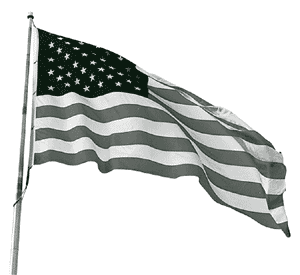Celebrating Flag Day
By Sam Blumenfeld
Printed in Practical Homeschooling #87, 2009.
 Flag Day seems to be a point in history long forgotten, but Sam Blumenfeld has brought it back to life.
Flag Day seems to be a point in history long forgotten, but Sam Blumenfeld has brought it back to life.

|

|
On June 14, 1777, the Continental Congress replaced the British Union
Jack, symbol of Britain’s royal and imperial power over its colonies,
with a new American flag. And that is why Flag Day is celebrated each
year on June 14.
The delegates in 1777 resolved, “That the flag of the thirteen United
States be thirteen stripes, alternate red and white, that the union be
thirteen stars, white in a blue field representing a new constellation.”
The birth of our flag was a momentous event in the new nation’s struggle
for Independence from Great Britain. The Declaration of Independence had
been signed the year before, and the former British colonies were now at
war with the mother country, a war which did not officially end until
the signing of the Treaty of Paris in 1783.
It is believed that this first American flag was sewn in Philadelphia by
the famous seamstress Betsy Ross, who had been given a sketch of the new
emblem, so we are told, by George Washington and a committee of
patriots. But Francis Hopkinson, a delegate to Congress from New Jersey,
claimed credit for having come up with the original design, which had
six-pointed stars. However, it was Ross who supposedly suggested
five-pointed stars . . . perhaps because she found them easier to sew.
A year later, this new flag, flown by Capt. John Paul Jones in the
Ranger, received its first salute from a foreign state at Quiberon Bay,
France, February 14, 1778. In 1795 Congress specified that the flag be
fifteen stripes and that the union be fifteen stars in a blue field. For
22 years the flag of 1795 flew ashore and afloat over civilian, military
and naval activities. It was the conquering flag in 13 out of 18 naval
battles in the War of 1812. It inspired Francis Scott Key in 1814,
during the battle at Fort McHenry, to write the stirring words of our
national anthem, the immortal “Star-Spangled Banner.”
That glorious flag, 30 by 42 feet in size, had been made by Mary
Pickersgill, an enterprising businesswoman who established a very
successful flag-making business in Baltimore. There is a Star Spangled
Banner Flag House museum in Baltimore, which homeschoolers in that area
ought to visit.
It was Samuel Reid (1783—1861), commander of a famous privateer during
the War of 1812, who, at the behest of Congressman Peter H. Wendover,
helped design the 1818 version of the flag, which established the rule
of keeping thirteen stripes to commemorate the thirteen colonies and
adding one star for each new U.S. state. Today, of course, the flag has
50 stars to represent our 50 states.

|
|
Photo courtesy of www.act-clipart.com
|
However, it was Bernard Cigrand (1866—1932), who is considered the
father of Flag Day. He was the first to organize a formal observance of
Flag Day in 1885 at a school in which he was teaching at Waubeka,
Wisconsin. Although he went on to become a dentist, he tirelessly
promoted the idea of making Flag Day a national holiday. His unwavering,
patriotic advocacy finally led President Woodrow Wilson to issue a
proclamation calling for a national observance of Flag Day on June 14,
1916. However, Old Glory’s birthday did not become an official day of
observance until August 1949, when President Harry Truman signed the
legislation that proclaimed June 14 as Flag Day.
And so, while Flag Day is still not a national holiday, it has become a
noteworthy day of observance by many Americans, particularly veterans of
our many wars. Since Truman’s signing, Americans have fought and died
for their country in the Korean War, the Vietnam War, the Gulf War, and
lately the wars in Iraq and Afghanistan. As we see so often see on TV,
soldiers killed in battle are brought back to the U.S. in coffins draped
with American flags, which at funerals are carefully folded and given to
the wives, husbands, and parents of the fallen heroes.
On Flag Day all government buildings and officials are required to
display the flag in celebration of its adoption as the official flag of
the United States. Citizens are urged to display the flag from their
private residences.
By Joint Resolution of Congress, a Federal Flag Code (Public Law 94—344)
was enacted proscribing the proper ways to display and honor the flag in
every possible situation. For example, “During rendition of the national
anthem when the flag is displayed, all present except those in uniform
should stand at attention facing the flag with the right hand being over
the heart.” When reciting the Pledge of Allegiance, the right hand
should also be placed over the heart.
Every homeschool should have a flag inside the house and, if possible, one flown outside, especially on Flag Day.
Education expert Sam Blumenfeld’s Alpha-Phonics reading program is
available on www.samblumenfeld.net. His latest book, The
Marlowe-Shakespeare Connection, is about the Shakespeare authorship
mystery.